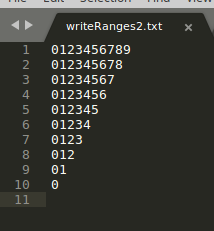
iterables, like lists, and for loops are building blocks of glorious software
python 2 home > fundamentals review mini-projects
Python fudamentals review
wb_incandescentOverview
Our original data analytics planning and curricular revision planned that students who have comleted python 1, or are python 2 ready, are basically flient with the Deitel text content through about the beginning of chapter 9 (files). To the extent that this fluency has gaps, these exercises encourage you to write code to accomplish mini-tasks using study resources.
Use the buttons above to navigate to the page sections
list Files & loops
bookResources
listLesson sequence
- Build a shared understanding of our file I/O tools on the white board using our linked resources
Exercise 1: Looping to a file
Study the following file contents. Generate a program in Python to reproduce this structure. NOTE: You'll need to use two for() loops, nested. You can try seeing if you can print the pattern out first to the console, then replace the calls to print() with calles to yourfile.write().

Exercise 2: String formatting program specification
- Download the following text file of names: file link
- Your desired program output is a formal greeting for individuals whose names exist in a text file in the order: first last. The output should look like this:
- The process of generating these greetings should take place in two functions: one should read in a file given a file name (assumed to be in the working directory) and extract the name in a single line. The second method should receive a line of text (i.e. a name in the form first last) and generate the greeting. Remember, you'll need to invert the string since we're using string formatting, not string concatenation.

vpn_keyMaps
account_treeTrees

 ) and wikimedia/wikipedia content embeds, which are always cited.
) and wikimedia/wikipedia content embeds, which are always cited.